

B lood Will
Tell Bird Dog Paintings by J.M. Tracy
B lood Will Tell
Bird Dog Paintings by J.M. Tracy
Copyright © 2017 by Red Fox Fine Art. All rights reserved.
Published in the United States by Red Fox Fine Art, Middleburg, Virginia.
Blood Will Tell: Bird Dog Paintings by J.M. Tracy October 2 – December 1, 2017
First American Edition, October 2017
No part of this publication may be reproduced, or stored in a retrieval system, or transmitted in any form or by any means - electronic, mechanical, photocopying, recording, or otherwisewithout written permission of the publisher.
All inquiries should be addressed to: Red Fox Fine Art, P.O. Box 385, Middleburg, Virginia 20118
ATTN: Turner Reuter, Jr.
ISBN-13: 978-0-692-95607-6
Printed in the U.S.A. by District Creative Printing, 6350 Fallard Drive, Upper Marlboro, Maryland
Front Cover: Detail of Reproof, oil on canvas, 16 x 24 inches John Martin Tracy (1843 – 1893) (Plate 9)
Author’s Note
Born in Rochester, Ohio, John Martin Tracy (1843-1893), whose life spanned only forty-nine years, showed an early aptitude toward the arts. In 1867, at the age of twentyfour, he was sent to France to study painting in Paris. There he attended the École des Beaux-Arts for two years where he worked under Carolus-Duran, the celebrated society portrait painter who claimed John Singer Sargent (1856-1925) as his star pupil. By 1870 Tracy was back stateside at the California School of Design in San Francisco, where he exhibited at the San Francisco Mechanics Institute from August 8 to September 7 of 1871, painting both intimate and majestic landscapes, much in the manner of Albert Bierstadt (1830-1902).* Often included in these early compositions were wild or domestic animals, indicating a growing affinity toward the animal portraiture that would later become his raison d’être. Tracy returned to France in the mid 1870’s where again he studied at the École des Beaux-Arts and also painted in the forests of Fontainebleau outside of Paris, working among a group of American expatriate artists perfecting the skills required to reproduce the human form.
By 1878, a mere eleven years after his formal artistic training began, Tracy returned to America and settled in St. Louis where his commission of a Champion Irish Setter won critical acclaim. Thus his career as a sporting artist was inadvertently launched and his future recognition in the genre as one of America’s finest in the field was soon established. Little then did anyone realize Tracy would be at his easel for only fourteen more years. Nevertheless, his body of work left a significant legacy, a sampling of which is contained in this exhibition Blood Will Tell: Bird Dogs by J.M. Tracy. In 1882 he moved to Greenwich, Connecticut, where he remained until 1886, later moving to New York City where he stayed for just one year, and then finally settling in Hempstead, Long Island by 1891.2 3
Sadly, for his contemporary admirers, there would be no more paintings from the artist after 1893. What then? A period of loss? Yes! With the exception of the book Diomed by John S. Wise, published in 1897, in which Tracy’s prowess as both an artist and sportsman afield was admiringly discussed,
his memory soon dimmed.4 Posthumously nothing much else came to light about the artist until April of 1936 when his talent was re-introduced to the public in A Loan Exhibition of Selected Works of America’s Great Sporting Painter J.M. Tracy at the Ehrich-Newhouse Gallery in New York.5 This exhibition came to fruition through the efforts of a young art dealer named Emanuel Jay Rousuck (1898-1970), whose brief biography follows. The show was accompanied by a catalog listing its thirty-two exhibits, several of which are re-examined here in Blood Will Tell. Rousuck wrote in the catalog preface …
Tracy will probably be best remembered in the end for his portraits of Gun Dogs. His likenesses of Pointers and Setters have the authoritative touch of the painter who knows his subject… (He)… judged our early Field Trials, and the first shows held by the Westminster Kennel Club, in whose clubrooms many of his pictures hung. The Gun Dogs of Tracy’s paintings were to become the pillars of the American Stud Books, the foundation stocks of the splendid sporting dogs of this country…
* Freeman Lloyd: “Born in Haverford West, in Wales, in 1859, fate started him in the centre of a sporting country and among men whom the best breeds of dogs were a mingled trade and religion. His uncle, the famous old Ben Lloyd, took the youngster’s canine education in hand; and found him a remarkable pupil. His parents had intended for the lad a career as gentleman farmer. Lloyd preferred to course or to shoot along the top of the earth rather than to delved into it with plow or harrow. ‘You’ll never make a farmer of him!’ croaked the neighbors, when they saw his bent as a nimrod and as a dogman. And they were right.” Excerpt from Albert Payson Terhune, “An Appreciation,” Dogdom, Battle Creek, MI: F.E. Bechmann, vol. 21, April, 1920, p. 53. Google Book Search. Web. 09/27/17.
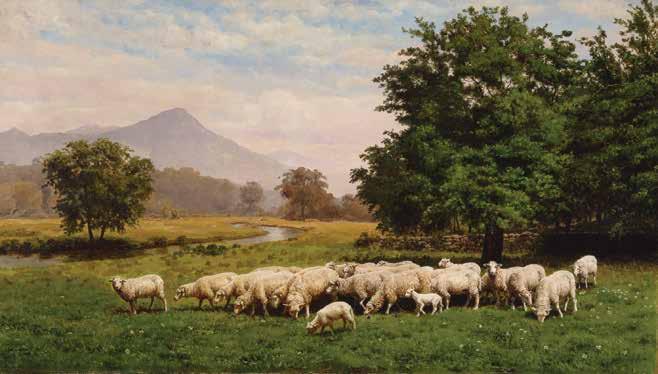
Since every important Tracy painting is a monument to a great dog or horse, his canvases are rarely offered for sale. For the most part, they remain household treasures of the foremost shooting and hunting families of America---treasures which have passed from father to son…
Assembling this collection has not been easy, but EhrichNewhouse feel that this exhibit is well worth the difficulties entailed. America is not yet conscious enough of her own sporting tradition; too many Americans are still unfamiliar with the work of a fine painter who has already immortalized American sport…6
Another tribute to Tracy occurred contemporaneously with Rousuck’s exhibit in the form of an article by Freeman Lloyd (b. 1859)*, the English sporting dog expert and author of books on spaniels, setters and whippets, in the May issue of the American Kennel Gazette titled The Dog Pictures of Tracy 7 This comprehensive and well-illustrated article revisited Tracy’s biography based on interviews with the artists’ daughter Marguerite Tracy following his death. Lloyd included comments about how breeding standards in the field and on the bench have developed since the artist’s death and dubbed Tracy the “American Landseer.”8
What then of Tracy’s 1936 revival? Because of it, would his place in the art historical community finally be recognized? Apparently not! Neither Lloyd’s research nor Rousuck’s
efforts to underline the importance of sporting traditions in American culture through Tracy’s art had any lasting effect.
With the exception of the writer Nash Buckingham, a noted outdoorsman and author, who wrote about Tracy’s work in his book Tattered Coat: Tales of Shooting and Fishing, published in 1939, renewal of a chance for wider public recognition of Tracy’s talent and an examination of how the art historical community might recognize the validity of his oeuvre would take another fifty years.9 The moment came in 1994 when Wildlife Art News printed a commentary written by Tom Davis titled In Search of J.M. Tracy.10 Davis continued his work on Tracy with the publication of “Proper Dignity” The Life and Art of J.M. Tracy in 1998, while writing as Editor-AtLarge for The Pointing Dog Journal. Both were well researched, skillfully crafted and included fine examples of Tracy’s paintings illustrated in color.11 The author compared Tracy to American artists like Edmund Osthaus (1858-1928) and Percival Rosseau (1859-1937), but ventured the opinion that only A.B. Frost (1851-1928), William Harnden Foster (18861941) and Robert Abbett (1926-2015) were in Tracy’s class. Whether or not one is an agreement with this assessment, it is refreshing to note that an art critic writing in the late 20th century recognized the truth in what Rousuck had been saying five decades earlier.
Pastoral Sheep, oil on canvas, 24x42 inches
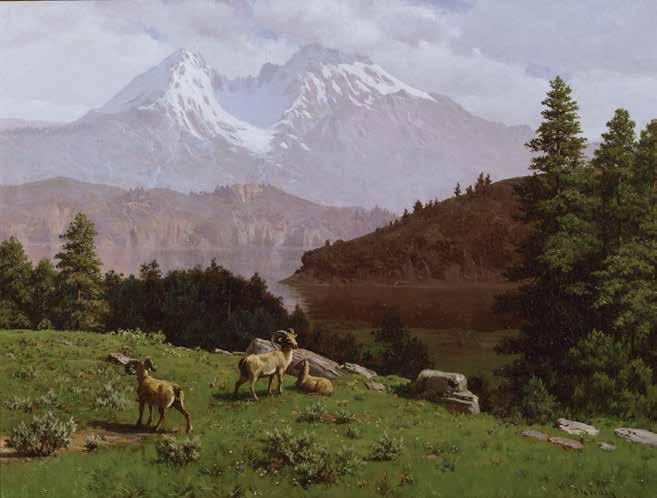
In Search of J.M. Tracy concluded with both a question and a prediction… “How can the current obscurity of an artist of Tracy’s caliber be explained?”…“Maybe, just maybe, this situation is about to change.”12 Now, one hundred and twentyfive years after the artist’s death and some twenty years after Davis penned his forecast, conditions under which Tracy’s work is judged have indeed “changed.” By the year 2000 the wider art historical community had finally accepted the caliber of his work and considered it a legitimate expression of late 19th century American life and culture. Rousuck would be pleased to learn that America had finally become conscious of her own sporting traditions, in part because of painters like Tracy.
Blood Will Tell aims to underline Tracy’s ability to explore the natural character and instincts of bird dogs and reveal relationships between these dogs and the landscape, other dogs, and between dogs and people.13 Relative to these relationships Tracy wrote …
My personal experience leads me to…value the high breeding in
In the Sierra Nevadres, oil on canvas, 24x32 inches
dogs. ‘Blood will tell’ is my doctrine. Since 1852, when I first began acquaintance with field dogs, I have seen many a scrub and mongrel who could work fairly well…but never one that could compare, even for pot hunting, let alone style, with blue-blood pointers or Llewellyn setters of the field-trial kind…It should be remembered that a dog hunts and points by natural instinct, and only needs to be trained to adjust his movements to those of his master.14
The main objective of my exhibit, like that of Rousuck’s seventy years ago, is to once again underscore the importance of Tracy’s place in American art and the American sporting tradition. Equally important and concurrent with this goal is the establishment of an instrument to develop and record a comprehensive monograph of the artist’s oeuvre, details of which are found in the “Afterward.”
Turner Reuter, Jr.
October 2017
A Note on Emanuel Jay Rousuck (1898-1970)
Rousuck was born in Cleveland, Ohio where he graduated from Western Reserve University. From his mid-twenties until his death at age seventy-two, he had an extensive career as an art advisor, dealer, collector, author and sportsman based in New York City. He was a lifelong bachelor blessed with handsome looks and impeccable manners. In 1926 he wrote and published The Boston Terrier, a book which became the standard reference for the breed. Later, after having established himself at the Ehrich-Newhouse Galleries Inc. in Manhattan, his first important position in the field of fine arts, he took up residence at 525 Park Avenue in an elegant apartment where he remained for the rest of his life.
Ehrich-Newhouse, originally M.A. Newhouse & Son of St Louis, Missouri, had moved to New York and merged with Ehrich Galleries, becoming Ehrich-Newhouse in 1934.15 While at Ehrich-Newhouse, 578 Madison Avenue, Rousuck mounted exhibitions in sporting art, his preferred area of interest, including A Loan Exhibition of Selected Works of America’s Great Sporting Painter, J.M. Tracy in 1936. In 1938, the gallery known again simply as Newhouse, mounted a retrospective exhibition on the equestrian works of another American painter, Edward Troye (1808-1874).16 Although Rousuck was determined to uphold the importance sporting art played in American life and culture from the historical sense, he also continued to hone his knowledge in the fields of Old Master Paintings and Impressionism, each growing mainstays of his business.
In 1946 he moved from Newhouse to Scott & Fowles at 745 Fifth Avenue in the Squibb Building. Scott & Fowles was founded in 1903 and had become a prominent American source for collectors and museums for 17th and 18th century British Paintings. Rousuck became President and owner of the gallery. While there he took on a keen interest in the artist Alfred Munnings, mounting exhibitions, writing essays and selling many of the Englishman’s works.
By July of 1953 Rousuck announced the merger of his Scott & Fowles with Wildenstein & Co, originally founded in Paris in 1875. He would become Vice President of the combined galleries known as Wildenstein & Co. at 19 East 64 th Street. At the time of the merger Cue Magazine called Mr. Rousuck … “a handsome dark-haired bachelor, who said during an interview ‘…(I’ve) sold nearly three million dollars’ worth of paintings during the past six years. Every year a Rembrandt or two…and in the past couple of years 90 sporting paintings by Munnings.’” 17
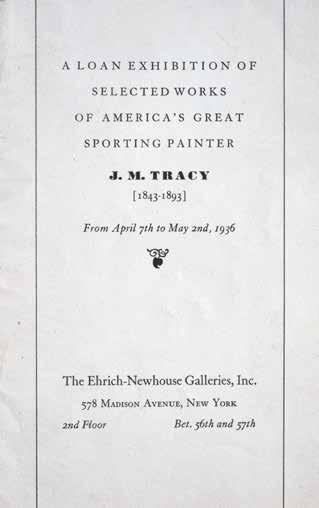
Over his career Rousuck helped form many collections of important Old Master, 18th and 19th Century British, Impressionist and Sporting Paintings. Notable ones in the Sporting Field include:
Crispin Oglebay Collection
The Crispin Oglebay Collection, subsequently named the Cripsin Oglebay Memorial Collection, gifted to the National Museum of Racing in Saratoga, New York, in 1962, is made up of fourteen works: eleven paintings and two sketches by Edward Troye (1808-1874), as well as one composition by Martin Stainforth (1866-1957). 18 The collection was given to the museum by one Mr. Courtney Burton, a relative of Crispin Oglebay. 19
F. Ambrose Clark Collection
Clark included much of his sporting art collection in his limited edition leather bound catalog titled The F. Ambrose Clark Collection of Sporting Paintings, 250 volumes of which were privately printed and distributed for his friends in 1958.20 Rousuck wrote the introduction and exhibit commentaries for the nearly 300 page volume and said of the collection “…it expresses a man and his way of life…This man is a great sportsman, amateur jockey, ardent foxhunter, excellent whip and shot.”21 One of the paintings in the 1936 exhibit A Loan Exhibition of Selected Works of America’s Great Sporting Painter, J.M. Tracy, “The Pointer “Robert le Diable” is in the Clark catalog.”
William Woodward Collection of English Thoroughbreds
Woodward, a member of the American Jockey Club, bred, raised and raced his horses from the famed Belair Stud near Baltimore, Maryland. The collection was bequeathed to The Baltimore Museum of Art where his wife funded and endowed a three story William Woodward Wing in 1956. Rousuck remarked “… (Woodward’s) profound knowledge of racing history, his sharp eye and impeccable taste, give the collection a remarkable importance as esthetic as it is historical.”22
National Museum of Racing Collection
In 1950 the National Museum of Racing Inc., later named National Museum of Racing and Hall of Fame, was formed in Saratoga. On August 6, 1951, an opening exhibit was held at the Canfield Casino with an exhibition of paintings, photographs and memorabilia in a ribbon cutting ceremony under the direction Cornelius Vanderbilt Whitney, the museum President, who’s first admitted guest was none other than William Woodward (see above). Along with Whitney, Rousuck was a guiding light in the Museum’s founding. He was responsible for many of its first acquisitions and in 1958 became Vice President. When the museum moved to its current permanent location at 191 Union Avenue in 1963, co-incidentally in the centennial year of the Saratoga Races, Rousuck was an integral figure in the planning and installation of the inaugural exhibit The National Museum of Racing, Equine Portraits, Sculptures and Histories and for the catalog essay The Thoroughbred in American Art which he authored.23
The Mellon Collection
Rousuck of course did not, by any means, entirely form the collection of Paul Mellon. But the two knew one another and Mellon was certainly a patron of Rousuck’s. What is important to note of the relationship between the two is that when Mr. Mellon had decided to establish the Yale Center for British Art
in New Haven, at his alma mater, he wrote Rousuck personally on December 6, 1966 from Washington. The note began with the handwritten salutation … “Dear Jay” and continued in type… “I didn’t want the news of this project to appear in the papers without you knowing about it beforehand, and I hope you will be happy about it…. The land is already available, but planning the building will probably take a year or two, and construction at least three or four more, so that I will be enjoying the pictures and books at home for a few more years! …You have yourself had a considerable part at one time or another in helping form the collections, and I hope this ultimate disposition pleases you!”…the note concluded with a hand written… “Sincerely, Paul.”24
Other notable Rousuck curriculum vitae highlights include:
Fellowship: Pierpont Morgan Library
Directorships: The City Investing Company, Investors Syndicate, Guaranty Trust, New York
Club Memberships: Clermont of London, Cornell of New York City, Deepdale of Manhasset, Madison Square Garden Club, Rowfant of Cleveland, Saratoga Golf Club and the Turf and Field Club
Authorships: Miscellaneous art and field sport magazine articles, catalog introductions and monographs not limited to the subjects of George Washington, Degas, Fantin-Latour, Augustus John, Ben Marshall, A. J. Munnings, Sargent and Edward Troye.
Gifts: While at Wildenstein, Rousuck was responsible arranging the gifting of the important reference library of the art critic and historian Julius Meier-Graefe (1867-1935), who authored the first history of 19th century painting and first critical essays on Renoir and Manet, to the National Gallery of Art in Washington.25
Exhibits
Plate 1 Marsh Shooting oil on canvas, 20 x 14 inches
Plate 2 In the Grouse Woods oil on canvas, 30 x 50 inches
Plate 3 Setters in a Corn Stubble oil on canvas, 18 x 30 inches
Plate 4 The English Cocker Spaniel, Champion Compton Brahmin oil on canvas, 22 x 30 inches
Plate 5 Good and Bad Luck oil on canvas, 23 ½ x 15 ½ inches
Plate 6 Gordon Setter oil on canvas, 16 x 24 inches
Plate 7 English Setter oil canvas, 16 x 24 inches
Plate 8 Faithful Companion oil on canvas, 13 x 11 inches
Plate 9 Reproof oil on canvas, 16 x 24 inches
Plate 10 In Quail Country oil on canvas, 30 ¼ x 50 ¼ inches
Plate 11 Field Trial, A Shot oil on canvas, 30 x 50 inches
Plate 12 Pointer Portrait oil on canvas, 16 x 24 inches
Plate 13 Biddy Backing Erin on Woodcock oil on canvas, 22 x 44 inches
Plate 14 Quail Shooting, The Retrieve oil on canvas, 15 x 24 inches
Plate 15 Hunting the Woodcock oil on canvas, 16 x 24 inches
Plate 16 Summer Woodcock oil on canvas, 23 ½ x 15 ½ inches
Plate 17 Gone Away oil on canvas, 12 ½ x 36 ½ inches
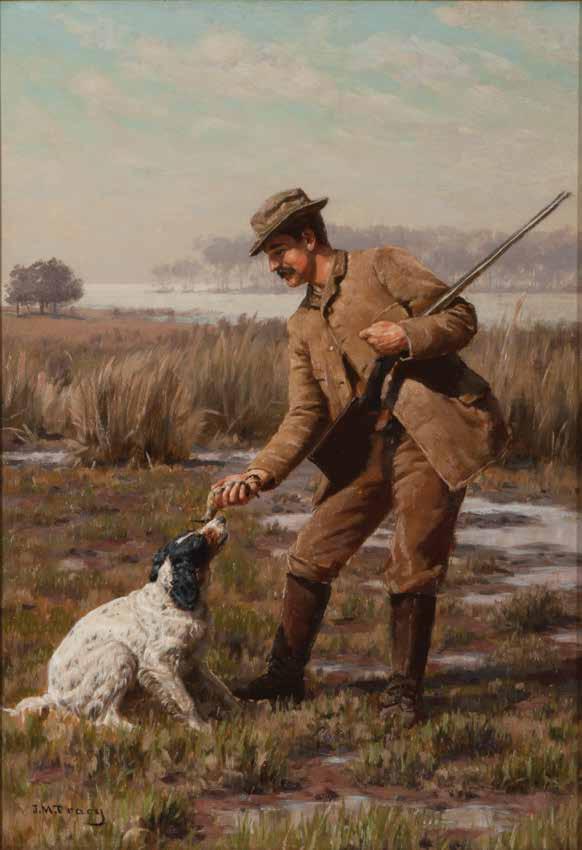
Blood Will Tell: Bird Dog Paintings by J.M. Tracy
Marsh Shooting
oil on canvas, 20 x 14 inches
The painting Marsh Shooting bears the label on its verso, Newhouse-Galleries 15 East 57th Street, New York, indicating that it was likely with these dealers during the time Tracy lived and worked in St. Louis, as the gallery was founded in the same city in 1878. At some point around 1936, Marsh Shooting as well as Plate 14 (Quail Shooting, the Retrieve) were acquired by Gerald M. and Eleanor (Geraldine) Livingston for their Dixie Plantation of 18,000 acres where each hung in the NeoClassical Revival Mansion designed by John Russell Pope until 1994, the year of Geraldine’s death.26 Straddling the FloridaGeorgia border in the Red Hills Region near Tallahassee, Dixie became a highly regarded wild quail hunting plantation and one of the finest field trial venues in North America, playing host to the important Shooting Dog Field Trial Championship known as “The Continental” since 1937.27
The painting depicts a sportsman out with his setter dog gunning for one of several variety of shorebirds commonly found in the marshlands adjoining rivers or tidal regions along coastlines. If indeed the work was executed while Tracy lived in St. Louis, he is likely the model for the sportsman accepting
the retrieve from his charge which is also the same dog depicted in Plate 8 (Faithful Companion).
The essay for Plate 11 (Field Trial, a Shot) makes reference to Hobart Ames’s Plantation that encompasses 18,000 acres of land, located approximately an hour from Memphis just north of the Tennessee-Mississippi line near Grand Junction, Tennessee. Ames Plantation, which is privately owned and operated by the Trustees of the Hobart Ames Foundation, is the home of the National Field Trial Championship for AllAge Bird Dogs.28
The American Sporting Tradition carries on in real life today through the generosity and bequests like those of the Ames and Livingston families. Just as Tracy’s art studies the natural character of bird dogs by exploring the relationships between the dogs and the landscape, other dogs, as well as between dogs and people, the field trial venues of “The Continental” and The National Championship assure these same relationships for future generations.
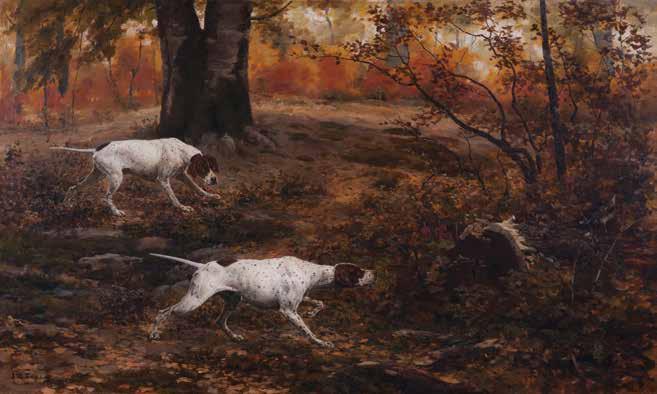
In the Grouse Woods
oil on canvas, 30 x 50 inches
Among the paintings by Tracy which Freeman Lloyd, the English sporting dog expert of the day, chose to illustrate in his seminal article The Dog Pictures of Tracy, 1936 was In the Grouse Woods.29 Lloyd’s caption of the image read…
…. The dog in the foreground would still represent the highest excellence in the present day specimens of the pointer breed. Note the exquisite style of the lower dog. 30
Plates 13 (Gone Away) and 17 (Biddy Backing Erin on Woodcock) are also among the illustrations chosen by Freeman.
Interestingly enough, breeding standards for the field and bench by which pointers are judged today have changed little since Tracy’s time, with the exception that in America a “twelve o’clock tail carriage” for dogs while on point is now the preferred conformation standard.
Toward the end of Tracy’s life, another like-minded American sporting artist, named William Harnden Foster (1886-1941), was born. The following comments were
penned in the forward of a book he wrote and illustrated about the North American Grouse, apt of Tracy’s belief that indeed ‘Blood Will Tell’…
“Foster’s interest in the New England Field Trials was constant and primarily directed to the introduction of a higher class conception of the working grouse dog…(He) recognized the grouse was a wise bird rather than a wild one. He also recognized that a high class bird dog possesses dominating instincts which at times overawe the bird and make them lie like stones (when pointed).”31
Tracy exhibited his work at the National Academy of Design between 1880 and 1891. His 1886 entry, when he was living in Greenwich, Connecticut, was no. 95, titled “The Home of the Grouse,” listed for a price of $300.32 It could very likely be “In the Grouse Woods.” Verification of this supposition and many more about the artist and his works is the aim of the forthcoming monograph project.
Plate 2


Setters in a Corn Stubble
oil on canvas, 18 x 30 inches
In his Setters in a Corn Stubble, Tracy juxtaposes the brace of setters with the crops among which they are working in a particularly pleasing harvest dialogue. The red and white setters, Irish and English, appear to have been quartering the cover in search of game when, while crossing one another’s pattern, each have simultaneously found birds and instantaneously, as is want, all motion has abruptly ceased under the influence of scent. The point sends shivers down the spine of any witness, a sight which causes the heart rate to rise in anticipation. Do the dogs have a single or a covey? Will the game hold until flushed by the sportsman and will there be a chance for a shot, or will the birds lift on their own out of range? Quick, quick, one
must get to the dogs. A sense of urgency prevails for the man or woman to be ready and forward on to the point, but the bird dogs remain staunch, not a muscle moving, eyes glazed, nose confident and sure, all still and quiet for the moment. The ripe fall crops, corn gone brown and dry, and pumpkins hard and bright orange, like the red and white setters working it before the point give the land a sense of particular peace. Now, walking up to the standing dogs, the landscape fades from consciousness, not to be recognized again until the echo of the last shot has quieted and the Irish and English are sent on in search of another covey.
Plate 3
The English Cocker Spaniel, Champion, Compton Brahmin
oil on canvas, 22 x 30 inches
Spaniels come from an ancient family of dogs of Spanish origin and were originally divided into two groups: those for upland hunting and those for waterfowling. For example, Springer Spaniels took their name from their springing action while Cocker Spaniels were named for their proficiency flushing game, especially the woodcock, in dense cover. The British Cocker was first imported to America in 1880, and recognized by the Kennel Club in 1892. Once in America, these spaniels developed differently in color and size, and by 1946 the American type became a recognized breed apart by the Kennel Club.34
Champion Compton Brahmin, a male, whelped April 15, 1881, by Easten’s Bob out of Clew, depicts the attributes of a dog bred for use afield.35 Mr. A. E. Rendle bred and campaigned Compton Brahmin under the name of Compton
Grove Kennels, in Greenwich, Connecticut, winning twentysix championships on the bench.36 37 38Across the pond, the Cocker is a very versatile dog used primarily for flushing and retrieving game. The Cocker is an excellent all-around companion for the sportsman who handles his or her own spaniel out rough shooting and on driven shoots by the beaters for flushing and pickers up collecting the bag. Small and very biddable, the Cocker also proves an ideal dog in the house and a suitable traveling companion in any vehicle. In the quail woods of the South, the Cocker has recently become a popular wagon dog, and one still hears in England and Ireland, during the woodcock migration, the song often sung by those working a Cocker in cover, “Put ‘em Up, Put ‘em Up, Put ‘em Up.”
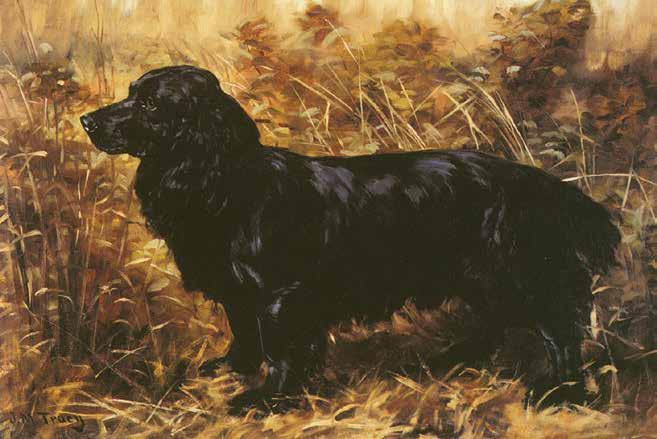
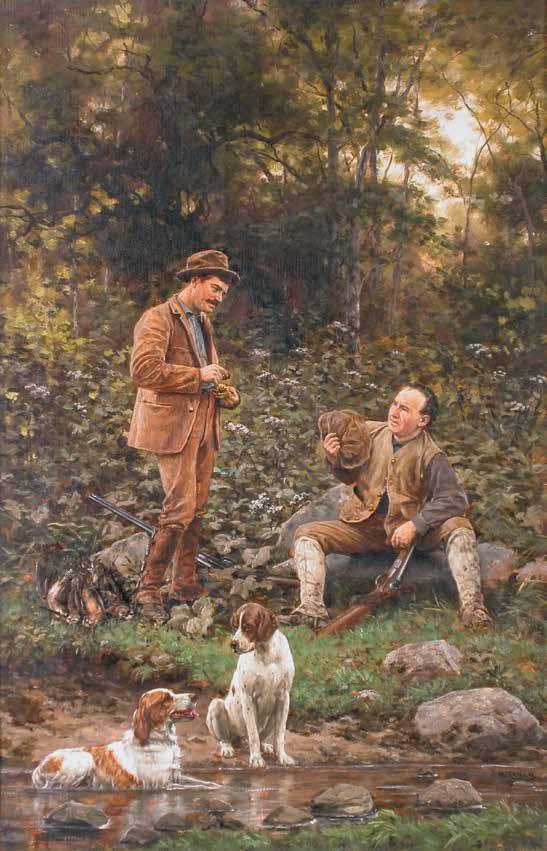
18 Blood Will Tell: Bird Dog Paintings by J.M. Tracy

Good and Bad Luck
oil on canvas, 23½ x 15½ inches
Clark Maylor’s book History of the Brooklyn Art Association and Index Exhibitions lists the painting Good and Bad Luck as exhibit #272, December 1884, $250.39 Another bird dog work from November 1883, #188, Retrieving also appears in the index, along with two pictures of cattle, one from December 1882 entitled Jersey Cow, $150, and one from November 1883 entitled The First Calf, $200. Good and Bad Luck was also reproduced for an 1889 poster for the DuPont Powder Company, bearing the inscription “DuPont Gun Powder OW 1889” and printed by the Chicago Bank Note Company.
Tracy was a prolific painter of woodcock gunning as is exemplified in the works of this exhibit, including Plates 13 (Biddy Backing Erin on Woodcock), 15 (Hunting the Woodcock) and 16 (Summer Woodcock). Summer woodcock shooting, much like gunning for the summer duck (wood duck), was a popular upland sport in the spring and summer months of the mid-Atlantic and Southern states. These migratory game birds were among the few species which remained there through the summer, where they raised and weaned their young. For example, in Ohio, where Tracy had grown up, the earliest birds are seen in February, but the bulk of the population does not arrive until March and April.
Once there they do not move out for winter until September, while some remain as late as mid-November.40
Good and Bad Luck was painted in 1884, ten years before the artist’s death, and therefore in the context of his oeuvre nearing the height of his prowess. As the title suggests the two sportsman shown characterize the contrast of positive and negative results. The narrative reveals each having gone separate ways in search of the wily timber doodle and having achieved mixed results. The one on the left with two brace (four head) in the bag stands upbeat, his tired setter cooling in the stream, while the seated man seems disappointed that he and his pointer have come up blank. The viewer doesn’t know the exact why and ware fore of the scene. However, was “bad luck” the result of poor dog work and no opportunities or just the opposite, well pointed game and poor shooting?
An encouraging result of the monograph project is that the image for The Pause that Refreshes, no. 23 of the 1936 EhrichNewhouse exhibit has come to light. Examination of their similarities supports the chance that Good and Bad Luck might be intended as its pair.

Gordon Setter41
oil on canvas, 16 x 24 inches
Tracy writes “The Black-and-Tan, or Gordon, setter has appeared to less advantage in America than other breeds. In public trials he has done little, and in private I have not been so fortunate as to see a brilliant performer, though of good, steady, practical dogs not a few, especially showing to advantages on snipe-marshes or in dense coverts…These dogs are to be recommended chiefly for their great beauty, and for their special adaptation to the use of sportsman of the North and East, where small fields, swampy ground, and dense coverts are principally worked…Such dogs are rare, and the owner of one has a treasure he can not too highly prize.”42 Like English Setter,
(Plate 7), Gordon Setter is another painting which falls within a category often used by the artist which illustrates a dog shown primarily in admiration of conformation and less in the act of intensity on point. Here the landscape serves as a framework in which the natural character of the dog is contained within the landscape, its feet placed firmly on the ground, its body in proper scale with the stone wall, all in harmony within the space. In a final meaningful touch, Tracy shows the Gordon in typical fashion of open mouth, tongue partially extended and searching eyes, all contributing to that spot-on expression we all know which reads … “I want to, please, let me.”
Plate 6
English Setter
oil on canvas, 16 x 24 inches
English Setter is a painting which falls within a category often used by Tracy which illustrates the setter dog shown primarily in admiration of conformation and less in the act of intensity on point. Like in Plate 6 (Gordon Setter) the landscape serves as a framework in which the natural character of the dog is contained. As the setter stands facing left, its feet placed firmly, realistically on the ground, the viewer has no difficulty judging the scale or size of the animal. In other words, one can imagine walking down a lane, turning a corner and there stands ahead that English setter in correct proportion with the space. Tracy
writes in great detail about conformation standards in his Concerning Pointers and Setters essays published in 1890 as one of a series of articles written by prominent sportsmen of the day contained in a book edited by William B. (Horace) Leffingwell titled Shooting on Upland, Marsh, And Stream, “In considering the action of pointers and setters, we must keep in view the fact that the animals are required to run for a long time at great speed, therefore their form must be as such to promote the best staying gait, which is quite different from that which would give the most rapid spurt.”44

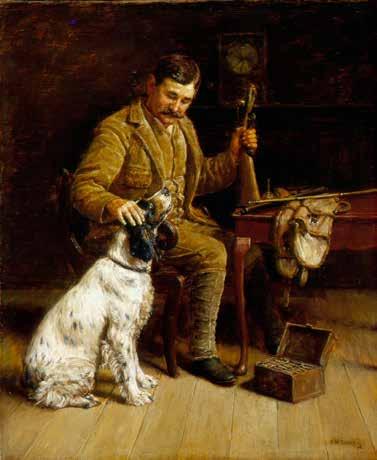
Faithful Companion
oil on canvas, 13 x 11 inches
Here, in Faithful Companion Tracy explores the natural character of a bird dog and tenderly portrays the instinctual loyalty it exudes for the human by emphasizing the eye contact between the two. What are they thinking, man and dog? The answer is obvious, yet the composition accomplishes much more. It serves as a window for us to see a moment in the history of American life and culture, and to simultaneously serve as an expression of ourselves. Man and dog are shown after a day afield gunning, now at rest seated before a fireplace, perhaps before their dinners. Compared to other canvasses in the exhibit this one is diminutive in scale to the others, but it reads like a much larger work, as it conveys multiple important messages. The clock on the mantle, for one, reminds us that the productive years in a bird dog’s life
are brief. Instinctually each understand the meaning of time, but in their mutual gaze the significance of it is ignored. A close look at Plate 1 (Marsh Shooting) indicates the setters in the two paintings are one and the same. It could be speculated that the two sportsmen are also identical. Their shooting attire is certainly similar as are their shotguns and their facial countenances. More important, however, is the fact that in each painting dog and man maintain their loyal and tender eye contact. In each scene the two are together but isolated from other dogs and people, and in each both are perfectly pleased with their solitude. In the context of American art, each painting shows the work of Tracy as legitimate and an integral reflection of our unique sporting tradition.
Plate 8
Reproof
oil on canvas, 16 x 24 inches
Reproof was first exhibited at the National Academy of Design in 1883, as exhibit no. 490, listed for the price of $200, entered by the artist from his Greenwich, Connecticut address.45 It next appeared on view to the public in Jay Rousuck’s 1936 show in New York at the Ehrich-Newhouse Gallery titled A Loan Exhibition of The Selected Works of America’s Great Sporting Painter J.M. Tracy [1843-1893], as no. 3, being loaned by one Mrs. Mottley Whitman.46 In the context of this painting, the title ‘Reproof,’ refers to an expression of blame, rebuke or reprimand. On a snowy day out for ‘yard work’ the handler has just intoned reproof of his pupil with raised finger and voice. The dog, admitting the mistake, manifests submission in its body language with a limp tail held between the legs, humped back and the inability to look the
handler in the eye, very unlike the gaze of mutual respect seen between animal and man in Plates 1 (Marsh Shooting) and 8 (Faithful Companion). Literally, reproof is part and parcel of developing a gundog’s natural instinct, revealing figuratively what is in the breeding and literally what is in the blood. Tracy both wrote about and trained his own dogs under doctrine he called “Blood Will Tell.” He said…
“The great trouble with highly bred dogs is, that few owners take the precaution to begin training their dogs into complete and willing obedience, but put them on game too soon…It should be remembered that a dog hunts and points by natural instinct, and only needs to be trained to adjust his movements to those of his master.”47
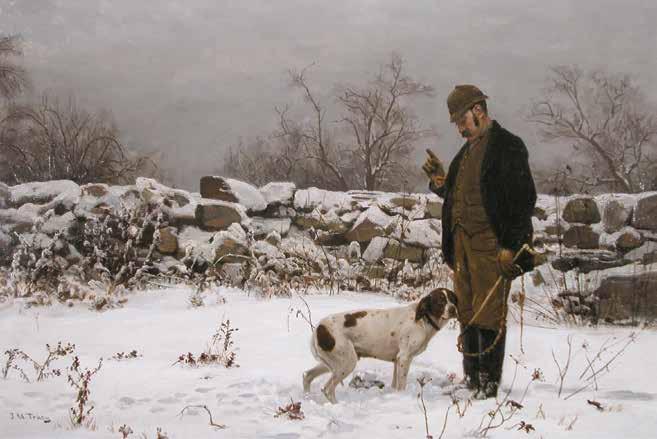

In Quail Country
oil on canvas, 30¼ x 50¼ inches
The title In Quail Country refers to the landscape of the composition, here a rural countryside in which quail are likely found, and of the time of year when the upland bird is fair game. This quail country landscape is typical of the midAtlantic region, whereas, in the vernacular, if one were quail shooting further to the south one would be shooting in the “quail woods.” Tracy depicts a brace of English pointers, named Croxteth (to the left) and Sensation (to the right), staunchly holding a quail covey presumed outside of the painting with two sportsmen easing ever forward and ready for the rise. This work hung in the Westminster Kennel Club, Tenafly, New Jersey until its closing in 1907. Sensation, lemon and white in color, was an English import originally called Don which the club
acquired in 1876 for the purpose of breed improvement and then subsequently renamed. Sensation was registered in the first (Volume 1) stud book of the National American Kennel Club, later called the American Kennel Club.48 The standards by which the first American bench shows judged pointers were clearly spelled out by Tracy, and by these standards Sensation proved a multiple winner.49 Sensation with its brace mate Croxteth, also an English import, competed in a new version of field trialling which was developing in America by 1880 at trialing grounds like the one on Robin’s Island in New York, and the one shown in Plate 11 (Field Trial, A Shot) 50 51
Plate 10
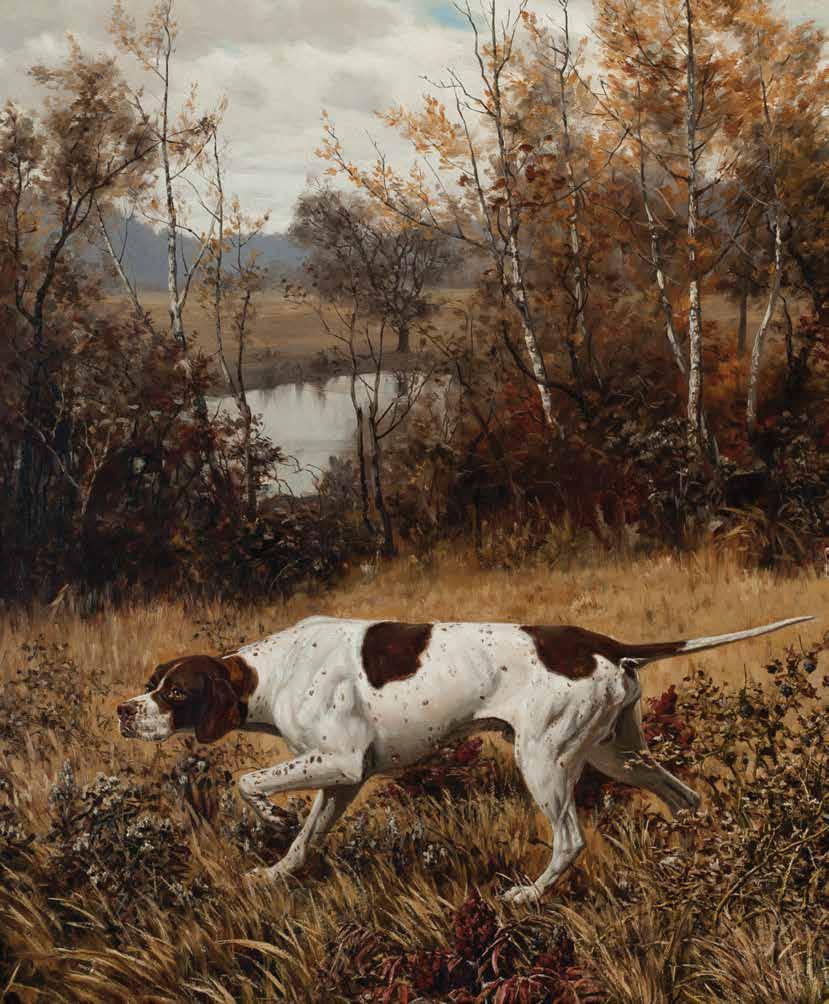
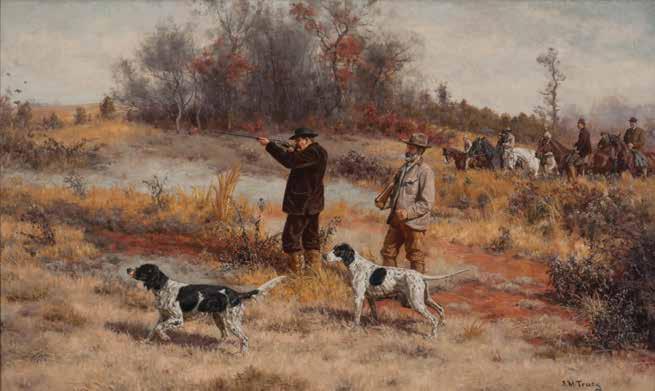
Field Trial, A Shot
oil on canvas, 30 x 50 inches
“Tracy’s painting, Field Trial, A Shot, c.1889, depicts a field trial in progress. Central to the composition is a brace of pointing dogs. The setter on the left has the birds, while the pointer on the right is ‘honoring,’ or acknowledging, the setter’s find.” 52 53 Recent scholarship notes the identities of the two dog handlers standing in the foreground. Cuthbert Buckle is shooting at a quail rising in a covey shown to the left of the canvas, while James Avent stands at ease with his pointer. “Buckle was the blunt-spoken Brit who served many years as the right-hand man to the legendary Hobart Ames, while Avent, ‘The Fox of Hickory Valley’, was a legend (bird dog developer) in his own right.”54 There are three recorded extant
‘Field Trial’ paintings by the artist in this scale and numerous ones of smaller sizes. Field trialing is a uniquely American sporting tradition run under strict rules that were established in 1874. Tracy was known as a fair and knowledgeable field trial judge, news of which has been reported from its inception in the weekly magazine The American Field, whose masthead was designed by the artist. It is the oldest continuously published sporting dog journal in the United States, dating from February 1874, and provides its readers with the latest news on purebred sporting dogs and field trial competition results.55
Pointer Portrait
oil on canvas, 16 x 24 inches
This endearing portrait by Tracy, of an unknown bitch, tells a story of a proud owner who commissioned a painting of the lemon and white female. She appears to have recently weaned a litter and has not yet slimmed down to working condition, but is nevertheless eager to get back afield. Her underlying conformation remains sound and of the type and standard to which Tracy, the ‘Bench Judge,’ holds true. “In color (the pointer) may be white, with liver, lemon, orange or black spots…(her) general appearance gives the impression of a bold, frank, dashing dog, carrying (her) head high, and having her shoulders quite above the level of (her) quarters, thus giving a decided slope to the line of (her) back.”56 Tracy continues in great detail about conformation standards in his
Concerning Pointers and Setters.57 This essay was published in 1890 as one of a series of articles written by prominent sportsmen of the day in a book edited by William B. (Horace) Leffingwell, titled Shooting on Upland, Marsh, And Stream. 58
Tracy exhibited his work at the National Academy of Design between 1880 and 1891. His 1890 entry, when he was living in Greenwich, Connecticut, was no. 587, titled “Study of a Pointer,” listed for the price of $125.59 It could very well be “Pointer Portrait.” Verification of this supposition and many more about the artist and his works is the aim of the forthcoming monograph project.
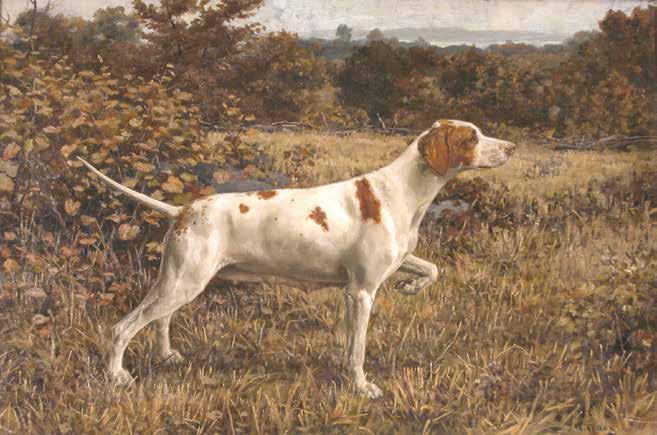
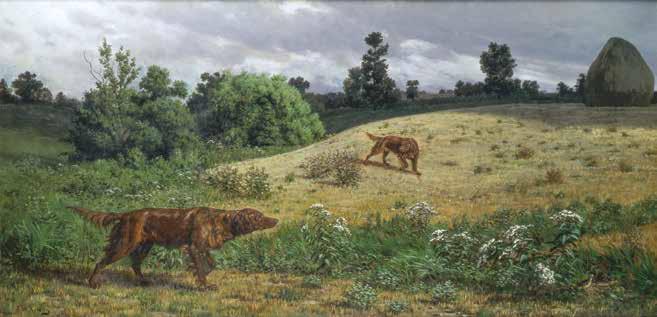
Biddy Backing Erin on Woodcock
oil on canvas, 22 x 44 inches
Biddy Backing Erin II on Woodcock is the title ascribed to the painting illustrated in the Tom Davis article published in the September/October 1994 issue of Wildlife Art News, In Search J.M. Tracy 60 The Irish setter pointing in the foreground surely has a woodcock (shown far right) pinned, while the other setter, Biddy, could be backing, but might have another bird to the front unseen. Freeman Lloyd also chose this painting as an illustration for his 1936 article, Dog Pictures of Tracy, with a caption that read: Irish Setters on point. Each appears to have made game… in different parts of the sligh-cover. 61 Tracy often painted the red setter, of which he wrote: “The very best field dog I ever saw was an Irish setter; For those that shoot a
great deal, and work the same dog on a variety of game, there is no dog like a good Irish setter. Hard, courageous, fast and with endurance unequaled, with a beautiful coat and cleanly habits to recommend him as a house dog, he will always be a favorite with men who keep but one dog.”62 Apropos of the exhibit, Tracy wrote one-hundred and twenty-seven years ago: “I consider that the ‘bird dogs’ are true and ancient breeds, whose instincts regarding their approach to game have been fixed for the ages so firmly, that they can only be disturbed by the introduction of the blood of some other breed having conflicting instincts.” 63


Quail Shooting, The Retrieve
oil on canvas, 15 x 24 inches
Quail Shooting, The Retrieve could very well be the painting listed as no. 14, “Quail Shooting” in Jay Rousuck’s 1936 exhibition shown in New York at the Ehrich-Newhouse Gallery titled A Loan Exhibition of The Selected Works of America’s Great Sporting Painter J.M. Tracy [1843-1893]. The answer to this question and others about the artist and his works will likely be forthcoming as the monograph gains traction.
Interesting observations of this composition liken the sportsman standing on the left in Quail Shooting, The Retrieve to the man on the left in Plate 10 (In Quail Country), and the lone sportsman in Plate 15 (Hunting the Woodcock). Perhaps Tracy painted the same model numerous times. It has also been suggested by some knowledgeable art critics that Tracy used his own personage as a model in Plates 1 (Marsh Shooting) and 8 (Faithful Companion). In that case these paintings must
date from the 1870’s when he was a younger healthier man in his thirties, since a photograph shown of the artist in Diomed pictures him as balding and grey by the time he was in his midforties.64
Tracy’s composition reveals a narrative of two sportsmen afield bound for quail with a brace of pointers at the time of a covey found, pointed, backed and flushed. One bird was shot on the rise and, true to the standards of the discipline demanded by the times, both dogs held steady to wing and shot, after which one was released to retrieve, while the other remained at heel. Concurrently, with slight regard for time, the sportsmen are taking in the moment with a smoke, in harmony with the landscape and pleased by the knowledge that in the case of their pointers Blood will Tell. 65
Plate 14
Hunting the Woodcock
oil on canvas, 16 x 24 inches
Tracy writes “… my favorite dog for upland shooting is the pointer; yet I can not claim for him any superiority over the setter, save that his coat does not gather burs…and my preference is founded solely on the pleasure I take in watching the play of the muscles unhidden by long hair. The breed is very ancient. As far back as we can trace it, through descriptions by writers and by old pictures, we find that it has not changed in the least in form, size, color or habits… Italy, Spain, France and England have in succession excelled in its production, as each for the time led the taste of the world in sport.”66 Hunting the Woodcock shows the lemon and white, English import, Sensation, also depicted in Plate 10 (In Quail Country), Sensation’s breeding was recoded in Volume 1 of the National American Kennel Club records, the first official registry for recognized canine breeds in the country.67 Sensation is shown pointing a single woodcock in late spring or summer in dense upland cover. However, his pointing style differs from that which is shown in Plate 10. Perhaps the bloom of the lush
green cover contributes to an olfactory challenge, causing lower head carriage, yet equal overall intensity. Just as in Plate 10, the sportsman on the left depicted here, who appears to be the same man, stands on the outside of the composition. In both works neither men are part of the action and each are in wonder at the grace and elegance of the hunter and hunted, captivated by the quiet and stillness, knowing soon the woodcock will break from cover in a flush of movement and sound.
Tracy exhibited his work at the National Academy of Design between 1880 and 1891. His 1887 entry, when he was living in Greenwich, Connecticut, was no. 17, titled “Woodcock Shooting,” and listed for the price of $250.68 It could very likely be “Hunting for the Woodcock,” shown here. Verification of this supposition and many more about the artist and his works is the aim of the forthcoming monograph project.
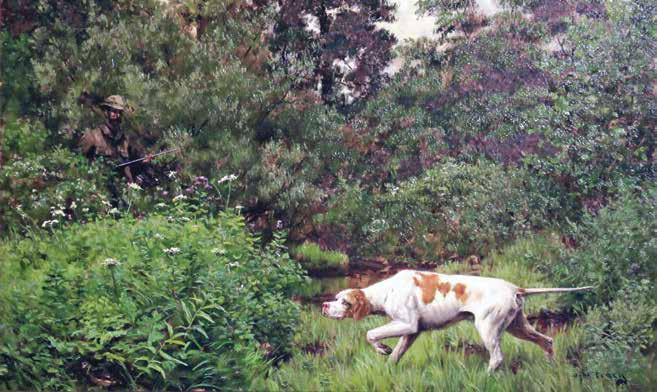
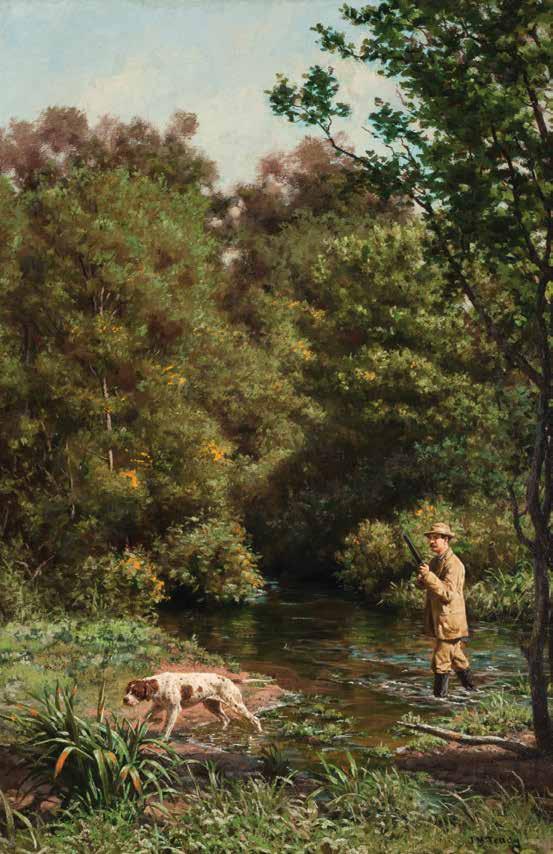
32 Blood Will Tell: Bird Dog Paintings by J.M. Tracy
Summer Woodcock
oil on canvas, 23½ x 15½ inches
Summer Woodcock is one of four paintings in Blood Will Tell depicting late spring and summer woodcock shooting, the others being shown are Plates 5 (Good and Bad Luck), 13 (Biddy Backing Erin on Woodcock), and 15 (Hunting the Woodcock). Back in Tracy’s day, well before the Federal Government began regulating migratory game birds, taking the woodcock in the spring and summers seasons despite its breeding, nesting and rearing cycles was both an acceptable pastime for sportsmen and business for the market gunners.
“By the late 1800s, the hunting and shipment of birds for the commercial market (to embellish the platters of elegant restaurants) and the plume trade (to provide feathers to adorn lady’s fancy hats) had taken their toll on many bird species. Passenger pigeons, whose immense flocks had once darkened the skies, were nearing extinction. The Lacey Act of May 25, 1900 prohibited game taken illegally in one state to be shipped across state boundaries contrary to the laws of the state where taken. It became an effective tool for enforcing the wildlife protective(protection) laws of both the States and the Federal Government. However, in the early years of the 20th century the Act was ineffective in stopping interstate shipments, largely because of the huge profits enjoyed by the market hunters and the lack of officers to enforce the law. These early failures of the Lacey Act led to passage of the Weeks-McLean
Law of March 4, 1913 which was designed to stop commercial market hunting and the illegal shipment of migratory birds from one state to another. The Act boldly proclaimed that: “All wild geese, wild swans, brant, wild ducks, snipe, plover, woodcock, rail, wild pigeons, and all other migratory game and insectivorous birds which in their northern and southern migrations pass through or do not remain permanently the entire year within the borders of any State or Territory, shall hereafter be deemed to be within the custody and protection of the Government of the United States, and shall not be destroyed or taken contrary to regulations hereinafter provided”… thus the Weeks-McLean Law rested on weak constitutional grounds, having been passed as a rider to an appropriation bill for the Department of Agriculture, and it was soon replaced by the Migratory Bird Treaty Act of 1918.” Excerpt from the U.S. Fish and Wildlife Service.69
The individuals for whom Tracy painted upland game and waterfowling subjects were for the most part responsible sportsmen. Therefore, once the need for wildlife conservation practices became evident, summer woodcock shooting became a pleasant memory for them, while a risky and illegal practice for the market gunners.
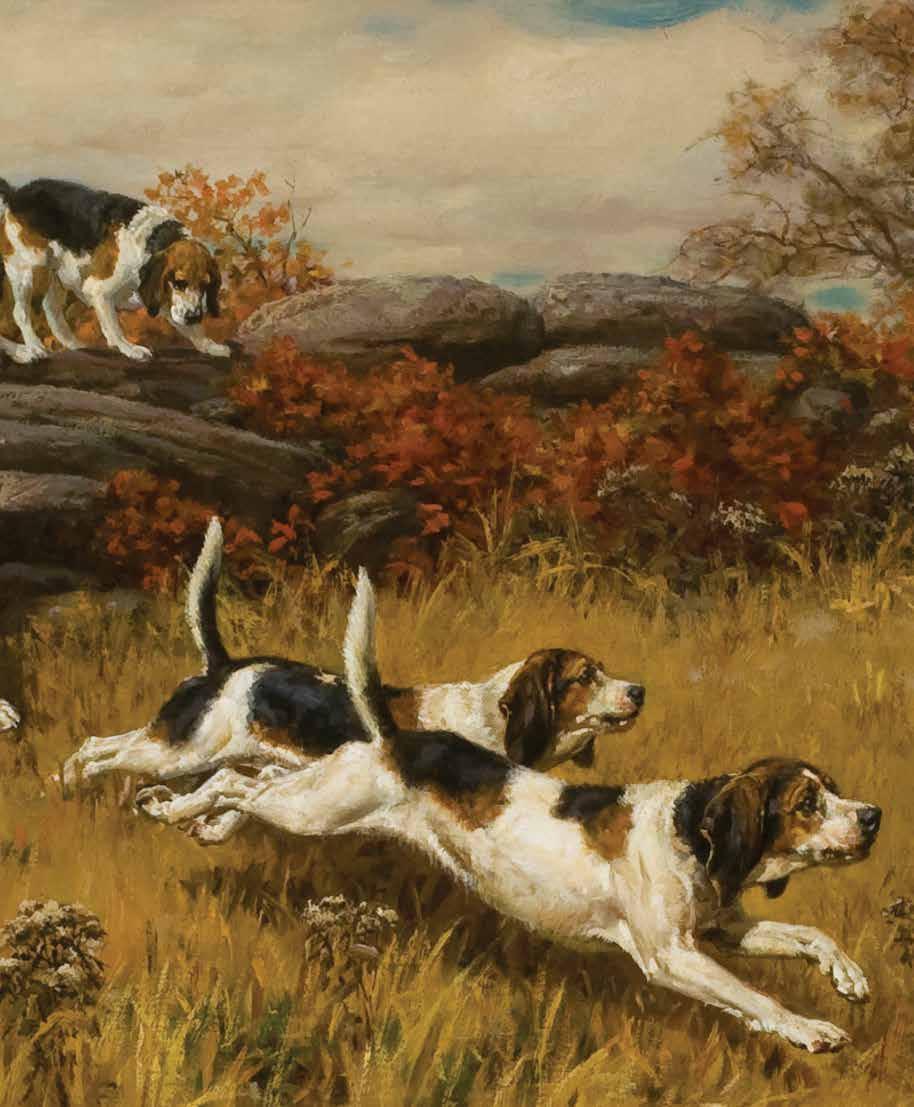
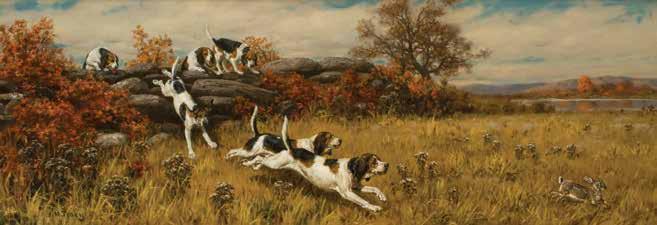
Gone Away
oil on canvas, 12½ x 36½ inches
In Gone Away, three couple of beagles in full cry are shown pushing a cottontail hard out of cover into, and across, open ground. Rabbit hunting, the American vernacular for Beagling, is an activity practiced afield with small specialty hounds which are customarily followed on foot. Tracy’s plein air composition strikes chords in the hearts of many of us who have had the opportunity to experience the chase, its sounds, sights and smells, and to enjoy the land in this fundamental way.70 Here the artist shows the viewer his talent in depicting motion and noise, unlike most of his bird dog paintings in
which pointers and setters are meant to be perfectly still and silent, pinning in a standoff whatever upland game bird has been found. Gone Away, although not a bird dog painting, is a part of the exhibit because the hounds, with their noses full of chest-high scent, are in hot pursuit, giving tongue guided by century’s old breeding instincts. Instinct can only be revealed through the training and handling of the pack, it cannot be taught, it is either in the blood or it is not…only Blood Will Tell.
Artist Biography
Tracy, John (Jonathan) Martin (1843 - 1893)
Excerpt from Animal and Sporting Artists in America by F. Turner Reuter, Jr. © 2008
Tracy was born in Rochester, OH, in 1843. He was the descendant of Mayflower passengers Elder Brewster and John Alden. His father was an abolitionist preacher (one source says he was a lawyer) who was killed in an antislavery riot before his son’s birth; his mother was among the first women journalists and a contemporary of Susan B. Anthony in the women’s suffrage movement. He grew up in the house of his grandmother, Orpha Conant, near Oberlin, OH. Tracy studied at Oberlin College and Northwestern University in Chicago, IL, then served in the Union Army during the Civil War beginning in 1861. In the late 1860s he worked as a fruit picker and a teacher around Egypt, in southern Illinois. He then went to France and studied in Paris in 1867 and 1868 at the École des Beaux-Arts with Carolus-Duran (Charles Emile Auguste Durant) and I. A. Pils. He was in the United States through most of the 1870s; during this period he is thought to have studied further at the California School of Design in San Francisco, where he painted a number of landscapes. It may be here that he executed his Bighorn - Sheep in the Sierras and his Grazing [Domestic] Sheep
After working in Chicago for a few years he returned to Paris in 1873, where he again attended the École des BeauxArts with Adolphe Yvon and, later, with Boisbaudran. Tracy became fluent in French and married the sister of the French sculptor Emile Guillemin, whom he had met on his first visit. Among Tracy’s circle of American friends and artists working together at the time near the forest of Fontainebleau outside of Paris included John Singer Sargent (qv), who painted a study of Tracy; James C. Beckwith (qv), the best man at his wedding; Will H. Low, who was named the executor of his
estate; George Inness (qv), with whom he shared a studio; and Theodore Robinson (qv), among others. Tracy exhibited at the Paris Salon in 1874 and 1876, showing a full-length portrait of his wife Mélanie in 1874. During this period he is said to have executed a battle picture, which included his own portrait, commissioned by the United States government, but no record of the painting has been found.
Upon his return to the United States in 1878 Tracy established himself in St. Louis, MO. He initially worked as a landscape and portrait artist, executing works both in his studio and outdoors; his commissioned subjects first included women and children, but later portraits of men participating in the field sports became his specialty. An unusual example is his Out for a Stroll, a large oil composition of Mr. and Mrs. August Belmont, Jr. walking together in the field, he with his cane and pointers and she with her collies. During his first year in St. Louis he was commissioned to paint a champion Irish setter. Thereafter he executed many canine commissions, especially hounds and gun dogs; he also painted horses including scenes of field trials. Around 1881 he settled in Greenwich, CT, and began wintering in Ocean Springs, MS. John Sergeant Wise’s 1897 book Diomed: the Life, Travels and Observations of a Dog, written as the autobiography of an English setter, covering whelping, rearing, training and all awww spects of work in the field, included two chapters about Tracy entitled “A Week with an Artist - [at] Pampatike [in King William County, VA]” and “How Pictures Representing Field Sports are Made”; the book was illustrated by John L. Chapman (qv). Tracy’s November on the James, an extensive composition depicting two sportsmen with pointers retrieving quail to hand with a black scout
holding their horses, was reproduced as an illustration in the latter chapter. Shooting on Upland, Marsh, and Stream, an anthology compiled by William Bruce Leffingwell in 1890, includes a comprehensive chapter written and illustrated by Tracy, entitled “Concerning Pointers and Setters,” covering the pedigree, anatomy and training methods of pointing dogs. Its contents reveal the artist’s thorough knowledge of the subject. This expertise, coupled with his awareness of the revolutionary kinematical studies of animals and humans by the English photographer Eadweard Muybridge, led the artist to become a much sought-after bench show and field trial judge, as well as a portrait painter. His portrait of the dual champion bench show and field trial pointer Robert le Diable is a unique commission in that the artist was also the judge at the Westminster Kennel Club show in New York City in 1886 where the dog was named champion. He also contributed articles and illustrations for The American Field, a weekly periodical published continually since 1874 and billed as “The Sports-man’s Newspaper of America-The Recognized Authority.” His vignettes of shooting over pointers, hare coursing trials, and angling were engraved by Weinhardt Engraving Company of Chicago, IL, and used as the mast head for this periodical in the 1880s and early 1890s. A number of Tracy’s works were also reproduced as lithographs, usually remarqued and signed in pencil by the artist, and copyrighted and published by Charles Klackner of New York City; examples include Home for the Hollidays, Full Cry, Chickens at the Setters’ Bowl, Beagles on a Rabbit, Southern Field Trials, 1891 and November on the James circa 1897.
Tracy exhibited works at the Westminster Kennel Club. He also exhibited in New York City at the National Academy of Design between 1880 and 1891, including Reproof in 1883, An Evening in the Field in 1884, The Home of the Grouse in 1886, Woodcock Shooting in 1887, Chesapeake Bay Dog and Study of a Pointer in 1890, and At the Farm, Hempstead, Long Island in 1891. The Smithsonian American Art Museum’s Inventory of American Paintings lists a number of his works, among them Cow with Waterfowl, Pointers, and Central Field Trials of 1891: Prince Lucifer, the Winner, Being Sent Off. His Southern Field Trials, 1891 was posthumously exhibited at the World’s Columbian Exposition in Chicago, IL, in 1893. The Morris Museum of Art in Augusta, GA, has his Shepherdess, A Field Trial - A Shot circa 1885 and Candidates for the Horse Show of 1893; the latter painting was on the artist’s easel in his studio in Mississippi at the time of his death. His work is also represented in the Manoogian Collection in Taylor, MI; the Phelan Collection in Chevy Chase, MD, which has his Botany,
a composition of a seated lady with flowers and a St. Bernard; the American Kennel Club Museum of the Dog in St. Louis, MO; and the National Museum of Wildlife Art in Jackson Hole, WY, which has A Field Trial. His Bighorn - Sheep in the Sierras is in a private collection in Virginia.
In 1936 the first comprehensive loan exhibition of the artist’s sporting works was held by The Ehrich-Newhouse Galleries, Inc. in New York City, which included an introductory essay by E. J. Rousuck. The paintings included Quail Shooting on the James River (reproduced in Diomed as November on the James), Central Field Trials, Lexington, NC; Reproof (a trainer and pointer in the snow); “Zip”; Close Work - “Maxim” and “Meteor” (pointers); Puppy; Sketch of a Chesapeake; English Setter; “Banjo” (a pointer); Candidates for the Horse Show (a mural of fourteen horses and grooms); “Firenzi”; Trotters at Goshen; “Jilt” (a pointer); Quail Shooting; “Lillie Burgess”; “Countess Rush”; “Medor,” son of Champion “Barnum” (a chesapeake); Sketch of a Filly; “Who’s Afraid”; Duck Shooting on the Chesapeake; Miss Johnson; Army Mule; The Pause that Refreshes; “Robert le Diable”; “Dashing Novice”; “Plantagenet”; Champion “Barnum” Retrieving Wild Goose; “Rockingham”; Meadowbrook Hunt, 1890 (illustrated in Van Urk’s The Story of American Foxhunting volume II); “Salvator”; Duchess of Ripon (a bloodhound); and “Lady May II”.
Tracy died in Ocean Springs, MS, on 20 March 1893, at the age of forty-nine. Contemporaries who knew him well suggested he died from anxiety and over-work in an effort to repaint and repair his entries to the 1893 World’s Colombian Exhibitions after they were damaged by a fire.
1 “J.M. Tracy (1834-1893),” Artist Files, Smithsonian Libraries’ Collection, Smithsonian American Museum of Art, Washington D.C. [accessed 08/15/17].
2 Ibid.
3 ed. Haverstock, Mary Sayre, Jeannette Mahoney Vance and Brian L. Meggitt, Artists in Ohio 1787 – 1900, Kent, OH: The Kent State University Press, 2000, p. 869.
4 John Sergeant Wise, Diomed, New York, NY: The Macmillan Company, 1905.
5 The Ehrich-Newhouse Galleries, Inc., New York, NY: A Loan Exhibition of Selected Works of America’s Great Sporting Printer J. M. Tracy, April 7 –May 2, 1936.
6 Ibid.
7 Freeman Lloyd, “The Dog Pictures of Tracy,” The American Kennel Gazette, May 1, 1936.
8 Ibid., p. 10.
9 Nash Buckingham, Tattered Coat – Tales of Shooting and Fishing, New York, NY: G.P. Putnam & Sons, 1939, p. 126.
10 Tom Davis, “In Search of J.M. Tracy,” Wildlife Art News, vol. 8, September/October 1994.
11 Tom Davis, “Proper Dignity, The Life and Art of J.M. Tracy,” The Pointing Dog Journal, July/August 1998.
12 Ibid.
13 F. Turner Reuter, Jr., Animal and Sporting Artists in America. Middleburg, VA: National Sporting Library, 2008, DVD/Lecture.
14 John Martin Tracy, “Concerning Pointers and Setters,” ed. William B. Leffingwell, Shooting on Marsh and Stream, IL and NY: Rand, McNally & Company, 1890, pp. 376-378.
15 “Newhouse Galleries,” Archives Directory for the History of Collecting, The Frick Collection, Web. 10/03/17. < http://research.frick.org/ directoryweb/browserecord.php?-action=browse&-recid=6134 >
16 National Sporting Library & Museum, Middleburg, VA: The Chronicle of the Horse in Art, August 26, 2016 – March 26, 2017, p. 2.
17 “About New York,” Cue Magazine, New York, NY: August 22, 1953, p. 13.
18 Victoria Reisman, (National Museum of Racing). “RE: Crispin Oglebay Collection,” message to Joseph Aulisi.10/03/17, E-mail.
19 Ibid.
20 E.J. Rousuck, The F. Ambrose Clark Collection of Sporting Paintings, New York, NY: Chanticleer Press, 1958.
21 Ibid.
22 “Horse Paintings to be Displayed, Baltimore Museum to Open Woodward Wing Housing Collection of 40 Years,” New York Times, New York, NY: November 4, 1956.
23 Letter from Paul Mellon to “Jay” Rousuck, December 6, 1966, Emanuel J. Rousuck Papers (1946-1970), Archives of American Art, Smithsonian Institution, Washington D.C. [accessed 08/22/17]
24 Ibid.
25 Emanuel J. Rousuck Papers (1946-1970), Archives of American Art, Smithsonian Institution, Washington D.C. [accessed 08/22/17]
26 Dixie Plantation Main House,” Dixie Plantation. Web. 10/03/17. < http://www.dixieplantation.org/index.php/history#main-house >
27 Ibid.
28 “About Us,” Ames Plantation. Web. 10/03/17. < http://www.amesplantation.org/about-us/ >
29 Freeman Lloyd, “The Dog Pictures of Tracy,” p. 8.
30 Ibid.
31 William Harnden Foster, New England Grouse Shooting, New York, NY: Charles Scribner’s Sons, 1942, p. xii.
32 ed. Maria Naylor, The National Academy of Design Exhibition Record 1861 -1900, vol.2 M – Z, New York, NY: Kennedy Galleries Inc., 1973, p. 942.
33 Image barcode #3107100218036 entitled Compton Brahmin (Champion), J.M. Tracy, The Frick Art Reference Library, New York: NY. [accessed 07/17/17]
34 William Secord, A Breed Apart: The Art Collections of the American Kennel Club and the American Kennel Club Museum of the Dog, Woodbridge, Suffolk, UK: The Antique Collectors’ Club, 2001, p. 149, 287.
35 Will Willwood, The Sportsman’s Directory Containing a Carefully Classified Descriptive Record of the Principle American Manufacturers of and Dealers in Guns, Ammunition, Fishing Tackle, and Sporting Goods; Dog Breeders, Kennel Clubs, State Sportsmen’s Associations, Fish Commissioners, Game Wardens, Racing and Trotting Associations, Athletic and Aquatic Clubs, Sporting Journals, Books and Publishers, Etc., Milwaukee, WI: Fred. E. Pond, 1891, p.126. Google Books Search. Web. 09/28/17.
36 “The Newark Dog Show: Awards,” Forest and Stream, vol. 26, March 1896, p.171. Google Books Search. Web. 09/28/17.
37 “Compton Brahmin no. 5863,” American Cocker Spaniel World Pedigree Database. Web. 09/28/17. < http://www.ingrus.net/amcocker/en/ details.php?id=7546 >
38 # 3107100218036 entitled Compton Brahmin (Champion) J.M. Tracy, The Frick Art Reference Library, New York: NY. [accessed 07/17/17]
39 Clark S. Marlor, History of the Brooklyn Art Association with an Index of Exhibitions, New York, NY: James F. Carr, 1970, p. 355.
40 Davis C. Dister, Joseph W. Hammond, Robert Harlan, Bernard F. Master, Bill Whan, Ohio Bird Records Committee Checklist of the Birds of Ohio, Westerville, OH: Ohio Department of Natural Resources, 2004. Web. 10/03/17. <https://web.archive.org/web/20040718101517/ http:/www.ohiobirds.org/publications/OBRClist.pdf >
41 entitled Gordon Setter, J.M. Tracy, The Frick Art Reference Library, New York: NY. [accessed 07/17/17]
42 Tracy, “Concerning Pointers and Setters,” pp. 395-397.
43 no. 922 entitled A Marbled Beauty (Gordon Setter), J.M. Tracy, The Frick Art Reference Library, New York: NY. [accessed 07/17/17]
44 Ibid., pp. 390-391.
45 Naylor, The National Academy of Design Exhibition Record 1861 -1900, p. 942.
46 The Ehrich-Newhouse Galleries, A Loan Exhibition of Selected Works of America’s Great Sporting Printer J. M. Tracy.
47 Tracy, “Concerning Pointers and Setters,” pp. 376-378.
48 National Sporting Library & Museum, Middleburg, VA: Side-By-Side with Gun & Dog, September 25, 2015 – March 20, 2016, plate 8, p. 19, 82.
49 Tracy, “Concerning Pointers and Setters.”
50 National Sporting Library & Museum, Side-By-Side with Gun & Dog, p. 82.
51 Ibid.
52 National Sporting Library & Museum, Middleburg, VA: Afield in America: 400 years of Animal & Sporting Art, October 11, 2011 –January 14, 2012, p. 131.
53 Robert G. Wehle, Snakefoot: The Making of a Champion, Henderson, New York, NY: The Country Press, 1996, p. 181.
54 Davis, “Proper Dignity, The Life and Art of J.M. Tracy,” p. 21.
55 “The American Field Magazine,” American Field Sporting Dog Association. Web. 10/03/17 <https://americanfield.villagesoup. com/p/the-american-field-magazine/150538 >
56 Tracy, “Concerning Pointers and Setters,” p. 386.
57 Ibid.
58 Ibid.
59 Naylor, The National Academy of Design Exhibition Record 1861 -1900, p. 942.
60 Davis, “In Search of J.M. Tracy,”, pp. 26-27.
61 Lloyd, “The Dog Pictures of Tracy,” p.11.
62 Tracy, “Concerning Pointers and Setters,” pp. 397-399.
63 Ibid., p. 397.
64 Wise, Diomed, p. 170.
65 Tracy, “Concerning Pointers and Setters,” p. 376.
66 Tracy, “Concerning Pointers and Setters,” p. 384.
67 National Sporting Library & Museum, Side-By-Side with Gun & Dog, p. 82.
68 Naylor, The National Academy of Design Exhibition Record 1861 -1900, p. 942.
69 “Other Relevant Laws,” U.S. Fish and Wildlife Service. Web. 10/03/17. <https://www.fws.gov/birds/policies-and-regulations/lawslegislations/other-relevant-laws.php#weeks>
70 National Sporting Library & Museum, Afield in America: 400 years of Animal & Sporting Art, p. 53.
Bibliography
“About New York,” Cue Magazine, New York, NY: August 22, 1953.
“About Us,” Ames Plantation. Web. 10/03/17 < http://www.amesplantation. org/about-us/ >
Buckingham, Nash. Tattered Coat – Tales of Shooting and Fishing, New York, NY: G.P. Putnam & Sons, 1939.
“Compton Brahmin no. 5863,” American Cocker Spaniel World Pedigree Database. Web. 09/28/17. < http://www.ingrus.net/amcocker/en/details. php?id=7546 >
Davis, Tom. “In Search of J.M. Tracy,” Wildlife Art News, vol. 8, September/ October 1994.
Davis, Tom. “Proper Dignity, The Life and Art of J.M. Tracy,” The Pointing Dog Journal, July/August 1998.
“Dixie Plantation Main House,” Dixie Plantation, Web. 10/03/17. <http:// www.dixieplantation.org/index.php/history#main-house>
Dister, Davis C., Joseph W. Hammond, Robert Harlan, Bernard F. Master, Bill Whan, Ohio Bird Records Committee Checklist of the Birds of Ohio, Westerville, OH: Ohio Department of Natural Resources, 2004. Web. 10/03/17 <https://web.archive.org/web/20040718101517/http:/www. ohiobirds.org/publications/OBRClist.pdf >
Emanuel J. Rousuck Papers (1946-1970), Archives of American Art, Washington D.C. [accessed 08/22/17].
Ehrich-Newhouse Galleries, Inc., The. New York, NY: A Loan Exhibition of Selected Works of America’s Great Sporting Printer J. M. Tracy, April 7 – May 2, 1936.
Foster, William Harnden. New England Grouse Shooting, New York, NY: Charles Scribner’s Sons, 1942.
Frick Art Reference Library, The. New York: NY [accessed 07/17/17].
ed. Haverstock, Mary Sayre, Jeannette Mahoney Vance and Brian L. Meggitt, Artists in Ohio 1787 – 1900, Kent, OH: The Kent State University Press, 2000.
“Horse Paintings to be Displayed, Baltimore Museum to Open Woodward Wing Housing Collection of 40 Years,” New York Times, New York, NY: November 4, 1956.
“J.M. Tracy (1834-1893),” Artist Files, Smithsonian Libraries’ Collection, Smithsonian American Museum of Art, Washington D.C. [accessed 08/15/17]
Lloyd, Freeman. “The Dog Pictures of Tracy,” The American Kennel Gazette, May 1, 1936.
Marlor, Clark S. History of the Brooklyn Art Association with an Index of Exhibitions, New York, NY: James F. Carr, 1970.
National Sporting Library & Museum, Middleburg, VA: Afield in America: 400 years of Animal & Sporting Art, October 11, 2011 – January 14, 2012.
National Sporting Library & Museum, Middleburg, VA: Side-By-Side with
Gun & Dog, September 25, 2015 – March 20, 2016.
National Sporting Library & Museum, Middleburg, VA: The Chronicle of the Horse in Art, August 26, 2016 – March 26, 2017.
Naylor, Maria, ed. The National Academy of Design Exhibition Record 1861 -1900, vol.2 M – Z, New York, NY: Kennedy Galleries Inc., 1973.
“Newhouse Galleries,” Archives Directory for the History of Collecting, The Frick Collection, Web. 10/03/17 < http://research.frick.org/directoryweb/ browserecord.php?-action=browse&-recid=6134 >
“Other Relevant Laws,” U.S. Fish and Wildlife Service. Web. 10/03/17 <https://www.fws.gov/birds/policies-and-regulations/laws-legislations/ other-relevant-laws.php#weeks >
“Paintings by the Late J.M. Tracy,” New York Times, New York, NY: February 17, 1845, p. 17
Reuter, F. Turner, Jr. Animal and Sporting Artists in America. Middleburg, VA: National Sporting Library, 2008.
Reisman, Victoria, (National Museum of Racing). “RE: Crispin Oglebay Collection,” message to Joseph Aulisi.10/03/17, E-mail.
Rousuck, E.J. The F. Ambrose Clark Collection of Sporting Paintings, NY: Chanticleer Press, 1958.
Secord, William. A Breed Apart: The Art Collections of the American Kennel Club and the American Kennel Club Museum of the Dog, Woodbridge, Suffolk, UK: The Antique Collectors’ Club, 2001.
Terhune, Albert Payson. “An Appreciation,” Dogdom, Battle Creek, MI: F.E. Bechmann, vol. 21, April, 1920. Google Book Search. Web. 09/27/17.
“The American Field Magazine,” American Field Sporting Dog Association. Web. 10/03/17 <https://americanfield.villagesoup.com/p/the-americanfield-magazine/150538 >
“The Newark Dog Show: Awards,” Forest and Stream, vol. 26, March 1896. Google Books Search. Web. 09/27/17.
Tracy, John, Martin. “Concerning Pointers and Setters,” ed. William B. Leffingwell, Shooting on Marsh and Stream, IL and NY: Rand, McNally & Company, 1890.
Wehle, Robert G. Snakefoot: The Making of a Champion, Henderson, New York, NY: The Country Press, 1996.
Willwood, Will. The Sportsman’s Directory Containing a Carefully Classified Descriptive Record of the Principle American Manufacturers of and Dealers in Guns, Ammunition, Fishing Tackle, and Sporting Goods; Dog Breeders, Kennel Clubs, State Sportsmen’s Associations, Fish Commissioners, Game Wardens, Racing and Trotting Associations, Athletic and Aquatic Clubs, Sporting Journals, Books and Publishers, Etc., Milwaukee, WI: Fred. E. Pond, 1891. Google Books Search. Web. 09/28/17.
Wise, John Sergeant. Diomed, New York, NY: The Macmillan Company, 1905.
J.M. Tracy Monograph Project
The primary aim of a John Martin Tracy Monograph is to compile and authenticate all current, and any future, information about the artist and his works in one central database. It is intended as a resource to verify and supply biographical information on the artist, as well as to act as a visual record for the artist’s works in the form of a catalogue raisonné, which will also contain all known print reproductions, photogravures, and calendars. For those interested in learning more or contributing to the monograph please address correspondence to:
J.M. Tracy Monograph
P.O. Box 385
Middleburg, Virginia 20118
Or contact Turner Reuter via email: tr@redfoxfineart.com
Index
Abbett, Robert, 7
Alden, John, 36
Ames, Hobart, 13, 26
A Field Trial, 37
An Evening in the Field, 37 Anthony, Susan B., 36 Army Mule, 37
At the Farm, Hempstead, Long Island, 37 Avent, James, 26
Banjo, 37
Beagles on a Rabbit, 37
Beckwith, James C., 36 Belmont, August, Jr., 36
Biddy Backing Erin on Woodcock, 11, 14, 19, 28, 33
Bierstadt, Albert, 6
Bighorn – Sheep in the Sierras, 36-37
Boisbaudran, ??
Botany, 37
Brewster, Elder, 36
Buckingham, Nash, 7 Buckle, Cuthbert, 26
Burton, Courtney, 9
Candidates for the Horse Show, 37 Carolus-Duran, 6, 36
Central Field Trials, Lexington, NC, 37 Central Field Trials of 1891: Prince Lucifer, the Winner, Being Sent Off, 37
Champion “Barnum” Retrieving Wild Goose, 37 Chap-man, John L., 36 Chesapeake Bay Dog, 37
Chickens at the Setters’ Bowl, 37 Clark, F. Ambrose, 10
Close Work - “Maxim” and “Meteor”, 37 Countess Rush, 37
Cow with Waterfowl, 37
Dashing Novice, 37 Davis, Tom, 7, 28
Degas, Edgar, 10
Duchess of Ripon, 37
Duck Shooting on the Chesapeake, 37
English Setter, 11, 20-21, 37
Faithful Companion, 11, 13, 22-23, 30
Fatin-Latour, Henri, 10
Field Trial, A Shot, 11, 24, 26, 37
Firenzi, 37
Foster, William Harnden, 7, 14
Frost, A.B., 7 Full Cry, 37
Gone Away, 11, 14, 34-35
Good and Bad Luck, 11, 18-19, 33
Gordon Setter, 11, 20-21
Grazing [Domestic] Sheep, 36
Guillemin, Emile, 36
Home for the Hollidays, 37
Hunting the Woodcock, 11, 19, 30-31, 33
In Quail Country, 11, 24-25, 30-31
In the Grouse Woods, 11, 14-15
In the Sierra Nevadres, 8
Inness, George, 36
Jilt, 37
John, Augustus, 10
Klackner, Charles, 37
Lady May II, 37
Leffingwell, William Bruce, 21, 28, 37
Lillie Burgess, 37
Livingston, Gerald M. and Eleanor, 13
Lloyd, Freeman, 7, 14, 28-29
Low, Will H., 36
Manet, Édouard
Marsh Shooting, 11-13, 22-23, 30
Marshall, Ben, 10
Martin, Mélanie, 36
Maylor, Clark, 19
Meadowbrook Hunt, 1890, 37 “Medor” Son of Champion “Barnum”, 37
Meier-Graefe, Julius, 10
Index
Mellon, Paul, 10 Miss Johnson, 37
Munnings, Alfred, 9-10
Muybridge, Eadweard
November on the James, 36 Oglebay, Crispin, 9 Osthaus, Edmund, 7
Out for a Stroll, 36 Pils, I. A., 36
Pastoral Sheep, 7 Plantagenet, 37
Pointer Portrait, 11, 27 Pointers, 37 Pope, John Russell, 13 Puppy, 37
Quail Shooting, 37
Quail Shooting, The Retrieve, 11, 13, 30
Quail Shooting on the James River, 37 Reproof, 11, 23, 37
Rendle, A. E., 17
Renoir, Pierre-Auguste, 10 Robert le Diable, 37 Robinson, Theodore, 36 Rockingham, 37 Rosseau, Percival, 7
Rousuck, Emanuel Jay, 6-7,9-10, 23, 30, 37
Salvator, 37
Sargent, John Singer, 6, 10, 36 Setters in a Corn Stubble, 11, 16 Shepherdess, 37
Sketch of a Chesapeake, 37
Sketch of a Filly, 37 Southern Field Trials, 1891 37
Stainforth, Martin, 9 Study of a Pointer, 37
Summer Woodcock, 11, 19, 32-33
The English Cocker Spaniel, Champion Compton Brahim, 11, 17
The Home of the Grouse, 37 The Pause that Refreshes, 37 Tracy, Marguerite, 7 Trotters at Goshen, 37 Troye, Edward, 9-10 Washington, George, 10 Whitman, Mottley, 23 Whitney, Cornelius Vanderbilt, 10 Who’s Afraid, 37 Wise, John Sergeant, 6, 36 Woodcock Shooting, 37 Woodward, William Yvon, Adolphe, 36 Zip, 37
44 Blood Will Tell: Bird Dog Paintings by J.M. Tracy
